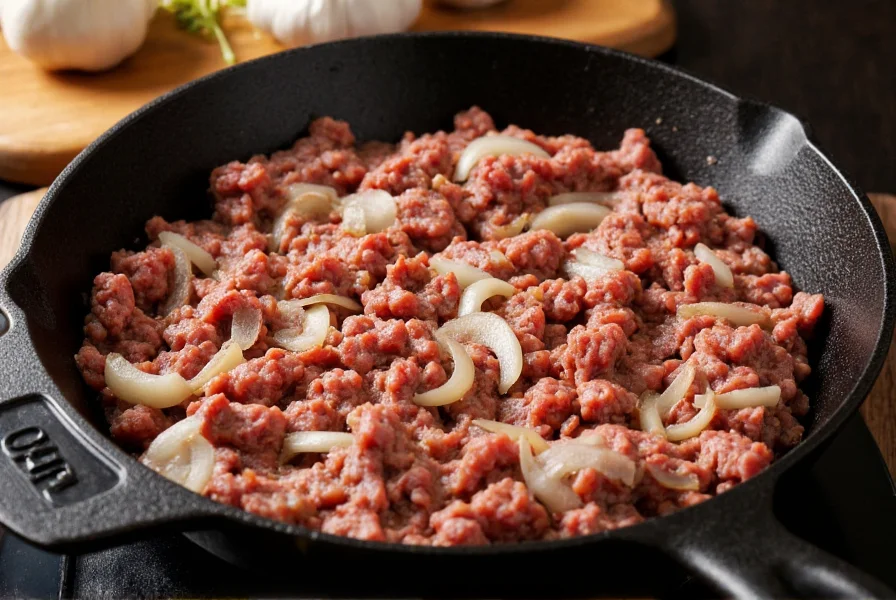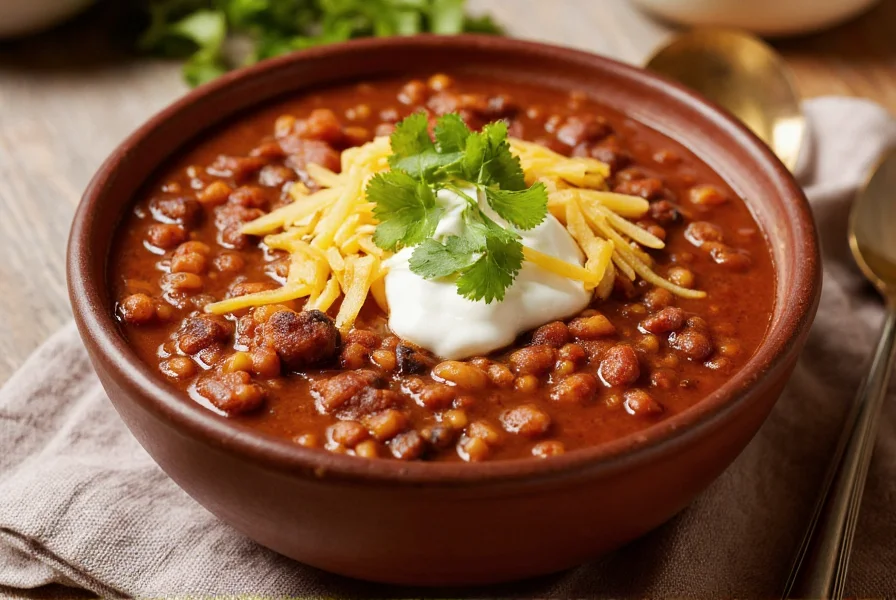Creating exceptional homemade chili requires understanding the delicate balance of ingredients and patience with the cooking process. Unlike rushed versions, authentic chili develops its signature flavor through proper layering of spices and sufficient simmer time. This guide provides a foolproof approach to making chili that delivers restaurant-quality results in your kitchen, whether you're using traditional stovetop methods or modern appliances like slow cookers and Instant Pots.
Essential Ingredients for Perfect Chili
The foundation of great chili starts with quality ingredients. While regional variations exist, these components form the backbone of a versatile chili recipe that can be customized to your taste preferences.
Meat Selection and Preparation
For traditional beef chili, use 80/20 ground chuck for optimal fat content that enhances flavor. Alternatively, try:
- 1.5 lbs ground beef (chuck or sirloin)
- 1 lb cubed chuck roast, diced 1/2 inch
- For turkey chili: 1.5 lbs ground turkey with 1 tbsp olive oil
Browning the meat properly is crucial—don't rush this step. Cook in batches if necessary to avoid steaming, which prevents proper caramelization. This Maillard reaction creates complex flavor compounds essential for depth in your chili.

Vegetables and Aromatics
Fresh vegetables provide the flavor base:
- 1 large yellow onion, finely diced (about 2 cups)
- 1 bell pepper (any color), finely diced
- 4-5 garlic cloves, minced
- 2 jalapeños, seeds removed for milder heat
Tomato and Liquid Components
The liquid base determines your chili's texture:
- 28 oz crushed tomatoes (San Marzano preferred)
- 15 oz dark red kidney beans, drained and rinsed
- 4 oz diced green chilies
- 1.5 cups beef or vegetable broth (low sodium)
- 2 tbsp tomato paste
| Ingredient | Amount | Function |
|---|---|---|
| Chili powder | 2 tbsp | Primary flavor base |
| Ground cumin | 1 tsp | Earthy depth |
| Smoked paprika | 1/2 tsp | Subtle smokiness |
| Cayenne pepper | 1/4-1/2 tsp | Controlled heat |
| Oregano (Mexican preferred) | 1/2 tsp | Herbal complexity |
Step-by-Step Cooking Process
Follow these professional techniques to build layers of flavor in your homemade chili recipe.
Building Flavor Foundations
- Brown the meat in a heavy-bottomed pot or Dutch oven over medium-high heat. Remove when well-browned and set aside.
- Sauté vegetables in the rendered fat until softened (about 8 minutes).
- Add tomato paste and cook for 2 minutes, stirring constantly to caramelize.
- Bloom spices by adding all dry spices to the vegetable mixture and cooking for 1 minute to release essential oils.
Simmering to Perfection
- Combine ingredients: Return meat to pot, add crushed tomatoes, beans, green chilies, and broth.
- Simmer gently covered for 45-60 minutes for stovetop method, stirring occasionally.
- Adjust consistency by adding more broth if too thick, or simmering uncovered if too thin.
- Final seasoning: Taste and adjust salt, acidity (with 1 tbsp lime juice), and heat level.
Adapting for Different Cooking Methods
Whether you're following an easy slow cooker chili recipe or using an Instant Pot, proper technique ensures success.
Slow Cooker Instructions
For the best crock pot chili from scratch, follow these steps:
- Brown meat and sauté vegetables as directed (don't skip this step!)
- Transfer to slow cooker with all remaining ingredients
- Cook on LOW for 6-8 hours or HIGH for 3-4 hours
- Remove lid for last hour to thicken if needed
Instant Pot Method
- Use Sauté function to brown meat and vegetables
- Add remaining ingredients and secure lid
- Cook on Manual/Pressure Cook for 15 minutes
- Natural release for 15 minutes, then quick release
- Simmer uncovered for 5-10 minutes to adjust consistency

Avoiding Common Chili Mistakes
Even experienced cooks make these errors when preparing homemade chili:
- Skipping the bloom step: Adding spices directly to liquid prevents flavor development
- Overcooking beans: Add canned beans in the last 30 minutes to prevent mushiness
- Insufficient simmer time: Chili needs at least 30 minutes to meld flavors properly
- Incorrect heat balance: Adjust cayenne gradually and remember heat intensifies over time
- Not tasting before serving: Final seasoning adjustments make the biggest difference
Customization Options for Dietary Preferences
Adapt this basic chili recipe to accommodate various dietary needs without sacrificing flavor.
Vegetarian and Vegan Chili
- Replace meat with 2 cups cooked lentils plus 1 cup textured vegetable protein
- Use vegetable broth instead of beef broth
- Add 1 cup roasted mushrooms for umami depth
- Include 1 cup corn kernels for texture variation
Regional Variations
Explore authentic chili styles:
- Texas-style: Omit beans and tomatoes, use only meat and chili peppers
- Cincinnati-style: Add chocolate and cinnamon, serve over spaghetti
- White chili: Use chicken, white beans, and green chili peppers
- Carne adovada: New Mexico style with red chile sauce and pork
Storage and Serving Recommendations
Proper storage enhances flavor while maintaining food safety.
- Refrigeration: Store in airtight container for up to 5 days
- Freezing: Portion into freezer bags (lay flat) for up to 6 months
- Reheating: Warm gently on stove with splash of broth to restore moisture
- Serving: Always offer toppings like sour cream, shredded cheese, and fresh cilantro
Chili's flavors deepen overnight as spices fully integrate. For best results, make chili one day ahead and reheat before serving. The complex flavor profile develops significantly during storage, making leftovers often superior to the initial batch.
Frequently Asked Questions
How can I make my chili less spicy if I've added too much heat?
Add dairy products like sour cream or shredded cheese directly to your serving bowl. For the entire batch, incorporate 1-2 tbsp of sugar or honey to balance heat, or add more beans and tomatoes to dilute the spice level. Acidic elements like lime juice can also help counteract excessive spiciness.
What's the difference between chili powder and chili seasoning?
Chili powder is primarily ground dried chilies with minimal additives, while chili seasoning contains additional ingredients like garlic powder, cumin, and oregano. For authentic chili, use pure chili powder and add individual spices to control flavor balance rather than relying on pre-mixed seasoning blends.
Can I make chili without beans and still have good texture?
Absolutely. Traditional Texas chili omits beans entirely. To maintain texture without beans, increase meat content by 50%, add diced potatoes during simmering, or include textured vegetable protein. Roasted mushrooms also provide excellent meaty texture in bean-free chili recipes.
How long should chili simmer for optimal flavor development?
For best results, simmer chili for a minimum of 45 minutes to allow flavors to meld. Two hours produces significantly better results as connective tissues in meat break down and spices fully integrate. Never boil vigorously—maintain a gentle simmer to prevent ingredient breakdown while developing complex flavors.
What's the secret to making chili thicker without overcooking?
Create a slurry with 2 tbsp cornstarch and 1/4 cup cold broth, then stir into simmering chili. Alternatively, remove 1 cup of chili, blend until smooth, and return to pot. For natural thickening, simmer uncovered for the final 15-20 minutes while stirring occasionally to prevent sticking.











 浙公网安备
33010002000092号
浙公网安备
33010002000092号 浙B2-20120091-4
浙B2-20120091-4